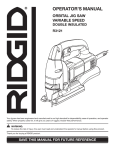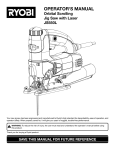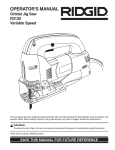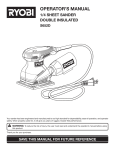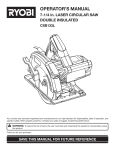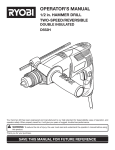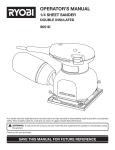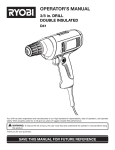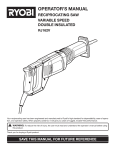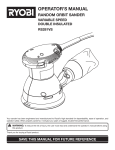Download Ryobi JS451L Operator`s manual
Transcript
OPERATOR’S MANUAL MANUEL D’UTILISATION MANUAL DEL OPERADOR orbital jIG sAW WITH LASER Scie sauteuse orbitale avec Laser Sierra de vaivén Orbital con Láser variable speed VITESSE VARIABLE VELOCIDAD VARIABLE JS451L Your jig saw has been engineered and manufactured to our high standard for dependability, ease of operation, and operator safety. When properly cared for, it will give you years of rugged, trouble-free performance. warning: To reduce the risk of injury, the user must read and understand the operator’s manual before using this product. Thank you for your purchase. SAVE THIS MANUAL FOR FUTURE REFERENCE Cette scie sauteuse a été conçue et fabriquée conformément aux strictes normes de fiabilité, simplicité d’emploi et sécurité d’utilisation. Correctement entretenue, elle vous donnera des années de fonctionnement robuste et sans problème. Su sierra de vaivén ha sido diseñada y fabricada de conformidad con nuestras estrictas normas para brindar fiabilidad, facilidad de uso y seguridad para el operador. Con el debido cuidado, le brindará muchos años de sólido y eficiente funcionamiento. AVERTISSEMENT : Pour réduire les risques de blessures, l’utilisateur doit lire et veiller à bien comprendre le manuel d’utilisation avant d’employer ce produit. ADVERTENCIA: Para reducir el riesgo de lesiones, el usuario debe leer y comprender el manual del operador antes de usar este producto. Merci de votre achat. CONSERVER CE MANUEL POUR FUTURE RÉFÉRENCE Le agradecemos su compra. GUARDE ESTE MANUAL PARA FUTURAS CONSULTAS TABLE OF CONTENTS Introduction....................................................................................................................................................................... 2 Warranty............................................................................................................................................................................ 2 General Safety Rules......................................................................................................................................................3-4 Specific Safety Rules........................................................................................................................................................ 4 Symbols.........................................................................................................................................................................5-6 Electrical............................................................................................................................................................................ 7 Features..........................................................................................................................................................................8-9 Assembly......................................................................................................................................................................9-10 Operation....................................................................................................................................................................10-15 Adjustments...............................................................................................................................................................16-17 Maintenance.................................................................................................................................................................... 18 Accessories..................................................................................................................................................................... 18 Parts Ordering / Service.....................................................................................................................................Back Page INTRODUCTION This product has many features for making its use more pleasant and enjoyable. Safety, performance, and dependability have been given top priority in the design of this product making it easy to maintain and operate. warranty RYOBI® POWER TOOL - LIMITED TWO YEAR WARRANTY AND 30 DAY EXCHANGE POLICY One World Technologies, Inc., warrants its RYOBI® power tools with the following conditions: 30-DAY EXCHANGE POLICY: During the first 30 days after date of purchase, you may either request service under this warranty or you may exchange any RYOBI® power tool which does not work properly due to defective workmanship or materials by returning the power tool to the dealer from which it was purchased. To receive a replacement power tool or requested warranty service, you must present proof of purchase and return all original equipment packaged with the original product. The replacement power tool will be covered by the limited warranty for the balance of the two year period from the date of the original purchase. WHAT THIS WARRANTY COVERS: This warranty covers all defects in workmanship or materials in your RYOBI® power tool for a period of two years from the date of purchase. With the exception of batteries, power tool accessories are warranted for ninety (90) days. Batteries are warranted for two years. HOW TO GET SERVICE: Just return the power tool, properly packaged and postage prepaid, to an Authorized Service Center. You can obtain the location of the Service Center nearest you by contacting a service representative at One World Technologies, Inc., P.O. Box 1207, Anderson, SC 29622-1207, by calling 1-800-525-2579 or by logging on to www.ryobitools. com. When you request warranty service, you must also present proof of purchase documentation, which includes the date of purchase (for example, a bill of sale). We will repair any faulty workmanship, and either repair or replace any defective part, at our option. We will do so without any charge to you. We will complete the work in a reasonable time, but, in any case, within ninety (90) days or less. WHAT’S NOT COVERED: This warranty applies only to the original purchaser at retail and may not be transferred. This warranty only covers defects arising under normal usage and does not cover any malfunction, failure or defects resulting from misuse, abuse, neglect, alteration, modification or repairs by other than Authorized Service Centers. One World Technologies, Inc. makes no warranties, representations or promises as to the quality or performance of its power tools other than those specifically stated in this warranty. ADDITIONAL LIMITATIONS: Any implied warranties granted under state law, including warranties of merchantability or fitness for a particular purpose, are limited to two years from the date of purchase. One World Technologies, Inc. is not responsible for direct, indirect, or incidental damages, so the above limitations and exclusions may not apply to you. This warranty gives you specific legal rights, and you may also have other rights which vary from state to state. — English GENERAL SAFETY RULES WARNING! Read all instructions. Failure to follow all instructions listed below may result in electric shock, fire and/or serious injury. The term “power tool” in all of the warnings listed below refers to your mains-operated (corded) power tool or battery-operated (cordless) power tool. Save These Instructions Work Area SAFETY Keep work area clean and well lit. Cluttered or dark areas invite accidents. Do not operate power tools in explosive atmospheres, such as in the presence of flammable liquids, gases or dust. Power tools create sparks which may ignite the dust or fumes. Keep children and bystanders away while operating a power tool. Distractions can cause you to lose control. ELECTRICAL SAFETY Power tool plugs must match the outlet. Never modify the plug in any way. Do not use any adapter plugs with earthed (grounded) power tools. Unmodified plugs and matching outlets will reduce risk of electric shock. Avoid body contact with earthed or grounded surfaces such as pipes, radiators, ranges and refrigerators. There is an increased risk of electric shock if your body is earthed or grounded. Do not expose power tools to rain or wet conditions. Water entering a power tool will increase the risk of electric shock. Do not abuse the cord. Never use the cord for carrying, pulling or unplugging the power tool. Keep cord away from heat, oil, sharp edges or moving parts. Damaged or entangled cords increase the risk of electric shock. When operating a power tool outdoors, use an extension cord suitable for outdoor use. Use of a cord suitable for outdoor use reduces the risk of electric shock. PERSONAL SAFETY Stay alert, watch what you are doing and use common sense when operating a power tool. Do not use a power tool while you are tired or under the influence of drugs, alcohol or medication. A moment of inattention while operating power tools may result in serious personal injury. Use safety equipment. Always wear eye protection. Safety equipment such as dust mask, non-skid safety shoes, hard hat, or hearing protection used for appropriate conditions will reduce personal injuries. Avoid accidental starting. Ensure the switch is in the off-position before plugging in. Carrying power tools with your finger on the switch or plugging in power tools that have the switch on invites accidents. Remove any adjusting key or wrench before turning the power tool on. A wrench or a key left attached to a rotating part of the power tool may result in personal injury. Do not overreach. Keep proper footing and balance at all times. This enables better control of the power tool in unexpected situations. Dress properly. Do not wear loose clothing or jewelry. Keep your hair, clothing and gloves away from moving parts. Loose clothes, jewelry or long hair can be caught in moving parts. If devices are provided for the connection of dust extraction and collection facilities, ensure these are connected and properly used. Use of these devices can reduce dust-related hazards. Do not wear loose clothing or jewelry. Contain long hair. Loose clothes, jewelry, or long hair can be drawn into air vents. Do not use on a ladder or unstable support. Stable footing on a solid surface enables better control of the power tool in unexpected situations. POWER TOOL USE AND CARE Do not force the power tool. Use the correct power tool for your application. The correct power tool will do the job better and safer at the rate for which it was designed. Do not use the power tool if the switch does not turn it on and off. Any power tool that cannot be controlled with the switch is dangerous and must be repaired. Disconnect the plug from the power source and/or the battery pack from the power tool before making any adjustments, changing accessories, or storing power tools. Such preventive safety measures reduce the risk of starting the power tool accidentally. Store idle power tools out of the reach of children and do not allow persons unfamiliar with the power tool or these instructions to operate the power tool. Power tools are dangerous in the hands of untrained users. Maintain power tools. Check for misalignment or binding of moving parts, breakage of parts and any other condition that may affect the power tool’s operation. If damaged, have the power tool repaired before use. Many accidents are caused by poorly maintained power tools. Keep cutting tools sharp and clean. Properly maintained cutting tools with sharp cutting edges are less likely to bind and are easier to control. Use the power tool, accessories and tool bits etc., in accordance with these instructions and in the manner intended for the particular type of power tool, taking into account the working conditions and the work to be performed. Use of the power tool for operations different from those intended could result in a hazardous situation. — English GENERAL SAFETY RULES SERVICE Have your power tool serviced by a qualified repair person using only identical replacement parts. This will ensure that the safety of the power tool is maintained. When servicing a power tool, use only identical replacement parts. Follow instructions in the Maintenance section of this manual. Use of unauthorized parts or failure to follow Maintenance instructions may create a risk of shock or injury. WARNING! To reduce the risk of injury, user must read instruction manual. SPECIFIC SAFETY RULES Hold power tools by insulated gripping surfaces when performing an operation where the cutting tool may contact hidden wiring or its own cord. Contact with a “live” wire will make exposed metal parts of the tool “live” and shock the operator. Use clamps or another practical way to secure and support the workpiece to a stable platform. Holding the work by hand or against your body leaves it unstable and may lead to loss of control. Know your power tool. Read operator’s manual carefully. Learn its applications and limitations, as well as the specific potential hazards related to this power tool. Following this rule will reduce the risk of electric shock, fire, or serious injury. Always wear safety glasses. Everyday eyeglasses have only impact-resistant lenses; they are NOT safety glasses. Following this rule will reduce the risk of serious personal injury. Protect your lungs. Wear a face or dust mask if the operation is dusty. Following this rule will reduce the risk of serious personal injury. Protect your hearing. Wear hearing protection during extended periods of operation. Following this rule will reduce the risk of serious personal injury. Inspect power tool cords periodically and, if damaged, have repaired at your nearest Authorized Service Center. Constantly stay aware of cord location. Following this rule will reduce the risk of electric shock or fire. Check damaged parts. Before further use of the power tool, a guard or other part that is damaged should be carefully checked to determine that it will operate properly and perform its intended function. Check for alignment of moving parts, binding of moving parts, breakage of parts, mounting, and any other conditions that may affect its operation. A guard or other part that is damaged should be properly repaired or replaced by an authorized service center. Following this rule will reduce the risk of shock, fire, or serious injury. Make sure your extension cord is in good condition. When using an extension cord, be sure to use one heavy enough to carry the current your product will draw. A wire gauge size (A.W.G.) of at least 16 is recommended for an extension cord 50 feet or less in length. A cord exceeding 100 feet is not recommended. If in doubt, use the next heavier gauge. The smaller the gauge number, the heavier the cord. An undersized cord will cause a drop in line voltage resulting in loss of power and overheating. Inspect for and remove all nails from lumber before using this power tool. Following this rule will reduce the risk of serious personal injury. LASER GUIDE WARNINGS: The laser guide radiation used in the Ryobi jig saw is Class II with maximum <1mW and 650nm wavelengths. These lasers do not normally present an optical hazard although staring at the beam may cause flash blindness. Caution: Use of controls or adjustments or performances of procedures other than those specified herein may result in hazardous radiation exposure. Avoid direct eye exposure when using the laser guide. The laser shall be used and maintained in accordance with the manufacturer’s instructions. Never aim the beam at a person or object other than the workpiece. Always ensure the laser beam is aimed at a sturdy workpiece without reflective surfaces. Shiny reflective sheet metal or similar shiny materials are not suitable for laser use. All repairs should be made by an authorized service representative or the laser manufacturer. If the power supply cord is damaged, it must be replaced only by the manufacturer or by an authorized service center to avoid risk. Save these instructions. Refer to them frequently and use them to instruct others who may use this product. If you loan someone this product, loan them these instructions also. — English SYMBOLS Some of the following symbols may be used on this product. Please study them and learn their meaning. Proper interpretation of these symbols will allow you to operate the product better and safer. SYMBOL NAME DESIGNATION/EXPLANATION V Volts Voltage A Amperes Current Hz Hertz Frequency (cycles per second) W Watt Power Minutes Time Alternating Current Type of current Direct Current Type or a characteristic of current No Load Speed Rotational speed, at no load Class II Tool Double-insulated construction Per Minute Revolutions, strokes, surface speed, orbits etc., per minute Wet Conditions Alert Do not expose to rain or use in damp locations. Read The Operator’s Manual To reduce the risk of injury, user must read and understand operator’s manual before using this product. Eye Protection Always wear safety goggles or safety glasses with side shields and, as necessary, a full face shield when operating this product. Safety Alert Precautions that involve your safety. No Hands Symbol Failure to keep your hands away from the blade will result in serious personal injury. No Hands Symbol Failure to keep your hands away from the blade will result in serious personal injury. No Hands Symbol Failure to keep your hands away from the blade will result in serious personal injury. No Hands Symbol Failure to keep your hands away from the blade will result in serious personal injury. Hot Surface To reduce the risk of injury or damage, avoid contact with any hot surface. min no .../min — English SYMBOLS The following signal words and meanings are intended to explain the levels of risk associated with this product. SYMBOL SIGNAL MEANING DANGER: Indicates an imminently hazardous situation, which, if not avoided, will result in death or serious injury. WARNING: Indicates a potentially hazardous situation, which, if not avoided, could result in death or serious injury. CAUTION: Indicates a potentially hazardous situation, which, if not avoided, may result in minor or moderate injury. CAUTION: (Without Safety Alert Symbol) Indicates a situation that may result in property damage. SERVICE Servicing requires extreme care and knowledge and should be performed only by a qualified service technician. For service we suggest you return the product to the nearest AUTHORIZED SERVICE CENTER for repair. When servicing, use only identical replacement parts. WARNING: To avoid serious personal injury, do not attempt to use this product until you read thoroughly and understand completely the operator’s manual. If you do not understand the warnings and instructions in the operator’s manual, do not use this product. Call Ryobi customer service for assistance. WARNING: The operation of any power tool can result in foreign objects being thrown into your eyes, which can result in severe eye damage. Before beginning power tool operation, always wear safety goggles or safety glasses with side shields and, when needed, a full face shield. We recommend Wide Vision Safety Mask for use over eyeglasses or standard safety glasses with side shields. Always use eye protection which is marked to comply with ANSI Z87.1. WARNING: Some dust created by power sanding, sawing, grinding, drilling, and other construction activities contains chemicals known to cause cancer, birth defects or other reproductive harm. Some examples of these chemicals are: • lead from lead-based paints, • crystalline silica from bricks and cement and other masonry products, and • arsenic and chromium from chemically-treated lumber. Your risk from these exposures varies, depending on how often you do this type of work. To reduce your exposure to these chemicals: work in a well ventilated area, and work with approved safety equipment, such as those dust masks that are specially designed to filter out microscopic particles. SAVE THESE INSTRUCTIONS — English ELECTRICAL DOUBLE INSULATION EXTENSION CORDS Double insulation is a concept in safety in electric power tools, which eliminates the need for the usual threewire grounded power cord. All exposed metal parts are isolated from the internal metal motor components with protecting insulation. Double insulated tools do not need to be grounded. When using a power tool at a considerable distance from a power source, be sure to use an extension cord that has the capacity to handle the current the product will draw. An undersized cord will cause a drop in line voltage, resulting in overheating and loss of power. Use the chart to determine the minimum wire size required in an extension cord. Only round jacketed cords listed by Underwriter’s Laboratories (UL) should be used. When working outdoors with a product , use an extension cord that is designed for outside use. This type of cord is designated with “W-A” or “W” on the cord’s jacket. Before using any extension cord, inspect it for loose or exposed wires and cut or worn insulation. WARNING: The double insulated system is intended to protect the user from shock resulting from a break in the tool’s internal insulation. Observe all normal safety precautions to avoid electrical shock. NOTE: Servicing of a product with double insulation requires extreme care and knowledge of the system and should be performed only by a qualified service technician. For service, we suggest you return the product to your nearest authorized service center for repair. Always use original factory replacement parts when servicing. **Ampere rating (on product data plate) 0-2.02.1-3.4 3.5-5.0 5.1-7.0 7.1-12.0 12.1-16.0 Cord LengthWire Size (A.W.G.) 25' 16 16 16 16 14 14 50' 16 16 16 14 14 12 ELECTRICAL CONNECTION 100' 16 16 14 12 10 — This product has a precision-built electric motor. It should be connected to a power supply that is 120 V, AC only (normal household current), 60 Hz. Do not operate this product on direct current (DC). A substantial voltage drop will cause a loss of power and the motor will overheat. If the product does not operate when plugged into an outlet, double-check the power supply. **Used on 12 gauge - 20 amp circuit. NOTE: AWG = American Wire Gauge WARNING: Keep the extension cord clear of the working area. Position the cord so that it will not get caught on lumber, tools, or other obstructions while you are working with a power tool. Failure to do so can result in serious personal injury. WARNING: Check extension cords before each use. If damaged replace immediately. Never use the product with a damaged cord since touching the damaged area could cause electrical shock resulting in serious injury. — English FEATURES PRODUCT SPECIFICATIONS Input.......................... 120 Volts, AC Only, 60 Hz, 4.8 Amps No Load Speed............................................600-2600/min. Orbital Settings.................................................................. 4 Laser Guide........................... Class II, <1mW max, 650 nm Stroke Length............................................................ 3/4 in. Net Weight................................................................5.8 lbs. LOCK-ON BUTTON SWITCH trigger VARIABLE SPEED CONTROL SELECTOR LED light Laser guide BASE ADJUSTMENT LEVER ORBITAL ADJUSTMENT KNOB RAPID CHANGE blade CLAMP anti-splintering INSERT saw base blade support roller VACUUM ATTACHMENT multi-purpose SAW BLADE blade storage AREA Fig. 1 — English FEATURES KNOW YOUR JIG SAW LED LIGHT See Figure 1. The safe use of this product requires an understanding of the information on the product and in this operator’s manual as well as a knowledge of the project you are attempting. Before use of this product, familiarize yourself with all operating features and safety rules. The LED light illuminates your work to give you a clear view of the cut line. ANTI-SPLINTERING INSERT The anti-splintering insert prevents splintering of the workpiece material for a smoother cut. It is especially helpful when cutting plywood. BASE ADJUSTMENT LEVER Using the base adjustment lever, you can make quick changes to the bevel setting. The base can be angled 45˚ left or right for bevel cutting, with indicators in 15˚ increments. BLADE SUPPORT ROLLER The blade-support roller is recessed to ensure accurate cutting. LASER GUIDE The laser guide projects a red line on your workpiece to give you a straight line to follow. LOCK-ON BUTTON The lock-on button allows continuous operation. ORBITAL ADJUSTMENT KNOB The orbital adjustment knob allows you to select four orbital settings to cut materials of varying thickness and density. RAPID CHANGE BLADE CLAMP There is a convenient lever on the blade clamp for changing saw blades without the need for seperate tools. VACUUM ATTACHMENT / BLADE STORAGE A vacuum attachment is packed with your saw. Used in conjunction with a vacuum cleaner, it will yield the highest dust removal efficiency. It features a built-in blade storage area. VARIABLE SPEED CONTROL SELECTOR The jig saw has a variable speed control selector to allow operator control of speed and power limits. assembly UNPACKING WARNING: This product requires assembly. n Carefully remove the product and any accessories from the box. Make sure that all items listed in the packing list are included. n Inspect the product carefully to make sure no breakage or damage occurred during shipping. n Do not discard the packing material until you have carefully inspected and satisfactorily operated the product. n If any parts are damaged or missing, please call 1-800-525-2579 for assistance. PACKING LIST Jig Saw Multi-Purpose Saw Blade Anti-Splintering Insert Vacuum Attachment Tool Bag Operator’s Manual If any parts are damaged or missing do not operate this product until the damaged or missing parts are replaced. Failure to heed this warning could result in serious personal injury. WARNING: Do not attempt to modify this product or create accessories not recommended for use with this product. Any such alteration or modification is misuse and could result in a hazardous condition leading to possible serious personal injury. WARNING: Do not connect to power supply until assembly is complete. Failure to comply could result in accidental starting and possible serious personal injury. — English ASSEMBLY installing BLADE clamping lever See Figure 2. NOTE: The jig saw is designed to use both T-shank and U-shank blades. Unplug the saw. Lift the clamping lever on the rapid-change blade clamp until it stops. Holding the clamping lever up, insert the saw blade (with blade teeth facing out) as far as possible into the slot in the saw bar. Check to make sure the back of the saw blade is centered in the groove of the roller guide. SAW BLADE u= t= Release the clamping lever. Make sure the blade is securely in place. installing vacuum attachment Fig. 2 See Figure 3. For dustless operation, a vacuum attachment has been provided with the saw which attaches to the saw base. To install: Unplug the saw. Slide the vacuum attachment into the curved area at the rear of the saw base until it is seated securely. Attach 1-1/4 in. vacuum hose to vacuum attachment. Connect vacuum hose to vacuum. To remove: Unplug the saw. Remove the vacuum attachment by pulling attachment from base. VACUUM ATTACHMENT Fig. 3 OPERATION APPLICATIONS WARNING: Do not allow familiarity with this product to make you careless. Remember that a careless fraction of a second is sufficient to inflict serious injury. WARNING: You may use this product for the purposes listed below: Cutting all types of wood products (lumber, plywood, paneling, composition board and hard board) Cutting thin sheet metal (metal cutting blade not included) Cutting plastics and laminates Always wear safety goggles or safety glasses with side shields when operating power tools. Failure to do so could result in objects being thrown into your eyes resulting in possible serious injury. STARTING / STOPPING THE SAW See Figure 4. To turn the saw ON, depress the switch trigger. Release the switch trigger to turn the saw OFF. 10 — English OPERATION LOCK-ON BUTTON LOCK-ON BUTTON See Figure 4. The saw is equipped with a lock-on feature which is convenient when continuous cutting for extended periods of time is required. To lock-on: Depress the switch trigger. Push in and hold the lock-on button located on the side of the handle. Release switch trigger. Release lock-on button. switch trigger To release: Depress the switch trigger to release. If you have the lock-on feature engaged during use and the saw becomes disconnected from power supply, disengage the lock-on feature immediately. Fig. 4 WARNING: Before connecting the saw to power supply source, always check to be sure it is not in lock-on position (depress and release switch trigger). Failure to do so could result in accidental starting of the saw resulting in possible serious injury. Also, do not lock the trigger on jobs where the saw may need to be stopped suddenly. SPLINTER-FREE CUTTING See Figure 5. The anti-splintering insert is especially useful when cutting plywood. It should only be used when making straight cuts or circle cuts. It is not for bevel cutting or plunge cutting. NOTE: The non-orbital setting also helps reduce splintering when cutting plywood. To attach and remove the anti-splintering insert: Unplug the saw. anti-splintering insert Fig. 5 Set the cutting angle at 0°. To attach, slide the insert back onto the tabs on the front of the base. Make sure it snaps securely into place. VARIABLE SPEED CONTROL SELECTOR To remove, grasp the anti-splintering insert and pull straight out. Variable SpEed Control selector See Figure 6. The saw has a variable speed control selector designed to allow operator control and adjustment of speed and power limits. The speed and power of the saw can be increased or decreased by rotating the variable speed control selector in the direction of the arrows shown in figure 6. NOTE: Hold the saw in normal operating position and turn the variable speed control selector to the positive ( + ) symbol to increase speed and power. Turn to the negative ( − ) symbol to decrease speed and power. 11 — English Fig. 6 OPERATION If you desire to lock the switch on at a given speed, depress the switch trigger, push in and hold the lock-on button, and release the switch trigger. Next, adjust the variable speed control selector until the desired speed is reached. Avoid running the saw at low speeds for extended periods of time. Running at low speeds under constant usage may cause your saw to become overheated. If this occurs, cool your saw by running it without a load and at full speed. The following guidelines may be used in determining correct speed for various applications: LOW speed is ideal when minimum speed and power is required, for example, starting cuts. MEDIUM speed is suitable for cutting hard metals, plastics, and laminates. HIGH speed produces best results when maximum power is required, for example, cutting wood. Soft metals such as aluminum, brass, and copper may also require high speeds. LED light Laser guide Fig. 7 WARNING: Do not insert saw blade into air vents. They could come in contact with electrically live internal parts, and cause electrical shock resulting in serious injury. LED LIGHT See Figure 7. The LED light illuminates when the switch trigger is depressed to give you a clear view of the cut line on your work surface. USING THE LASER GUIDE See Figure 7. WARNING: Do not stare into the laser beam. Failure to heed this warning could result in possible serious personal injury. The laser unit comes from the factory already installed and aligned. If the laser becomes misaligned after time refer to the Adjustments section. TO DECREASE ORBITAL SETTING The jig saw is equipped with a laser guide to project a red line to show the cut path. Pull the switch trigger to engage the laser guide. 1 2 The laser guide will turn on with the jig saw and continue to stay on for the cutting operation. The laser guide will turn off when the switch trigger is released. 3 TO INCREASE ORBITAL SETTING GENERAL CUTTING Rest the front of the saw base on the workpiece and align cutting edge of the blade with the line on your workpiece. Make sure the power cord is out of your way and not in the line of cut. Start the saw and move it forward on the work surface. Apply downward pressure to keep the saw steady Fig. 8 and only enough forward pressure to keep the blade cutting. Do not force the saw. Applying too much forward pressure to the saw may overheat the motor and break saw blades. 12 — English OPERATION ORBITAL MOTION See Figure 8. The blade of the saw cuts in an orbital motion. This feature is adjustable and provides faster, more efficient cutting. With orbital motion the blade cuts through your work in the upstroke but does not drag across your work in the downstroke. The higher settings should be used when fast cutting in soft material is desired. The lower settings should be used when cutting materials with more resistance. The “0” setting shuts off the orbital motion. Setting “3” offers the maximum orbital motion. STRAIGHT CUT See Figures 9 - 10. A straight cut can be made by clamping a piece of wood or straight-edge to the workpiece and guiding the edge of the saw against it. Make the cut from one direction only. Don’t cut halfway and complete the cut from the opposite end. You can also use an edge guide (not included) as shown in figure 10. Loosen the thumb screw and insert the end of the edge guide through the two slots in the base. Measure the distance to cut and tighten the thumb screw. Place the edge guide on the outside edge of the workpiece and cut in a straight path. Fig. 9 thumb screws WARNING: To avoid possible serious injury, keep hands and fingers from between the gear housing and saw blade clamp, and keep the guard in place. optional edge guide WARNING: Excessive side pressure to the blade could result in broken blades or damage to the material being cut. Fig. 10 ANGLE CUTTING (BEVEL CUTTING) See Figure 11. Bevel cutting angles may be adjusted from 0° to 45° right or left. Angles for cuts from 0° to 45° in 15° increments are marked on a scale on both the left and right side of the base. An arrow under the motor assembly provides an indicator at each of the above mentioned 15° increments. A protractor is recommended when accurate cuts are required. Unplug the saw. Unlock the base by moving the base adjustment lever forward. unlock lock base adjustment lever Slide the base forward to release it from the 0º detent position. indicator arrow Align the mark of the desired angle with the indicator arrow located on the housing. Once the desired angle is reached, tighten the base adjustment lever by moving it back under the motor assembly. 13 — English SLIDE FORWARD TO ROTATE BASE scale Fig. 11 OPERATION SCROLL CUTTING See Figure 12. Scroll cuts can be made with the jig saw by guiding the direction of the cut with applied pressure on the handle as shown. NOTE: Tighter tolerance scroll cutting may require the use of a scroll cutting blade (not included). WARNING: Excessive side pressure to the blade could result in broken blades or damage to the material being cut. PLUNGE CUTTING See Figure 13. NOTE: Use only a 7-teeth-per-inch blade for this type of cut. WARNING: To avoid loss of control, broken blades, or damage to the material being cut, always use extreme caution when making plunge cuts. We do not recommend plunge cutting on materials other than wood. Fig. 12 Mark the line of cut clearly on the workpiece. Set the orbit adjustment to “0”. Set the cutting angle at 0°. Tilt the saw forward so that it rests on the front edge of the base and blade will not come in contact with the workpiece when the saw is turned on. Make sure the blade is inside the area to be cut. Using high speed, start the saw and slowly lower the blade into the workpiece until the blade cuts through the wood. Continue lowering the blade into the workpiece until the base rests flat on the work surface, then move the saw forward to complete the opening. Fig. 13 14 — English OPERATION METAL CUTTING See Figure 14. NOTE: The jig saw has to be in the no-orbit mode to cut metals and conduit. Set the orbital adjustment knob to “0.” Many kinds of metals can be cut with the saw using a metal blade (not included). Be careful not to twist or bend the blades. Do not force. If the blade chatters or vibrates excessively, use a finer-tooth metal-cutting blade. If blade heats excessively, use lower speed. If blade teeth become filled or clogged when cutting soft metals, such as aluminum, use a coarser-tooth blade or lower speed. We recommend use of lubricant when cutting metals to keep blades cool, increase cutting action, and prolong blade life. Clamp the work firmly and saw close to the clamping point to eliminate any vibration of the work being cut. When cutting conduit, pipe, or angle iron, clamp work in a vise if possible and saw close to the vise. To cut thin sheet materials, “sandwich” the material between hardboard or plywood and clamp the layers to eliminate vibration and material tearing. By doing this, the material will be cut smoothly. Lay out your pattern or line of cut on top of the “sandwich.” NOTE: When cutting metal, keep exposed portion of saw bar clean and free of metal chips by wiping frequently with an oily cloth. Use extreme caution in disposing of oily cloth after completion of job to prevent potential fire hazard. 15 — English Fig. 14 ADJUSTMENTS WARNING: base plate Screws Before performing any adjustment, make sure the product is unplugged from the power supply and the switch is in the OFF ( O ) position. Failure to heed this warning could result in serious personal injury. base plate tightening BASE ADJUSTMENT LEVER See Figures 15 - 16. The base adjustment lever may need occasional tightening. Unplug the saw. If attached, remove the vacuum attachment. Remove the base plate screws and base plate by removing the four base screws to expose the adjusting nut. Release the base adjustment lever by pulling it forward. Tighten the adjusting nut 1/4 of a turn in the clockwise direction. base Engage the adjustment lever by pushing it back under the motor assembly and check the base for any movement. If the base is still loose, release the adjustment lever and tighten the adjusting nut another 1/4 of a turn. Repeat until the base is secure after engaging the adjustment lever. Reinstall the base plate and four base plate screws. Fig. 15 adjusting nut Fig. 16 16 — English ADJUSTMENTS LASER GUIDE ADJUSTMENT See Figure 17. Draw a pencil line on a scrap workpiece. The line should be approximately 12 inches long and should run all the way to the edge of the workpiece. Connect the jig saw to the power supply. Align the blade of the jig saw with the pencil line on the workpiece. Depress the switch trigger and cut into the workpiece until the base of the saw is fully supported by the workpiece as shown. Once the cut is finished, do not allow the saw to move throughout the rest of the adjustment process. NOTE: Ignore the projected laser line during this cut. Follow the pencil line visually to keep the blade cutting along the pencil line. Rotate the variable speed control selector to the lowest speed possible. Depress the switch trigger again to illuminate the laser. Take note of the position of the laser line in relation to the pencil line. If they are not together, unplug the jig saw and perform adjustment steps below as needed until lines come together. upper laser adjustment screw WARNING: Failure to unplug the saw could result in accidental starting causing possible serious personal injury. lower laser adjustment screw flat blade screwdriver If the laser line is completely to the left of the pencil line, turn the upper laser adjustment screw clockwise using a small flat blade screwdriver. This will cause the laser line to slide right. If the laser line is completely to the right of the pencil line, turn the upper laser adjustment screw counterclockwise. This will cause the laser line to slide left. If the laser line is twisted so that part of the line is to the left of the pencil line and part of the line is to the right, rotate the lower laser adjustment screw as necessary to bring the two lines together. WARNING: Use of controls or adjustments or performance of procedures other than those specified herein could result in hazardous radiation exposure. laser line at right side laser line at left side pencil line 17 — English Fig. 17 MAINTENANCE WARNING: When servicing, use only identical replacement parts. Use of any other parts may create a hazard or cause product damage. WARNING: Always wear safety goggles or safety glasses with side shields during power tool operation or when blowing dust. If operation is dusty, also wear a dust mask. GENERAL MAINTENANCE Avoid using solvents when cleaning plastic parts. Most plastics are susceptible to damage from various types of commercial solvents and may be damaged by their use. Use clean cloths to remove dirt, dust, oil, grease, etc. WARNING: Electric tools used on fiberglass material, wallboard, spackling compounds, or plaster are subject to accelerated wear and possible premature failure because the fiberglass chips and grindings are highly abrasive to bearings, brushes, commutators, etc. Consequently, we do not recommend using this product for extended work on these types of materials. However, if you do work with any of these materials, it is extremely important to clean the product using compressed air. LUBRICATION All of the bearings in this product are lubricated with a sufficient amount of high grade lubricant for the life of the unit under normal operating conditions. Therefore, no further lubrication is required. POWER SUPPLY CORD REPLACEMENT If replacement of the power supply cord is necessary, this must be done by an authorized service center in order to avoid a safety hazard. Do not at any time let brake fluids, gasoline, petroleumbased products, penetrating oils, etc., come in contact with plastic parts. Chemicals can damage, weaken or destroy plastic which may result in serious personal injury. ACCESSORIES Look for these accessories where you purchased this product: Edge Guide....................................................................................................................................................... 631097001 WARNING: Current attachments and accessories available for use with this product are listed above. Do not use any attachments or accessories not recommended by the manufacturer of this product. The use of attachments or accessories not recommended can result in serious personal injury. 18 — English Notes 19 — English OPERATOR’S MANUAL / orbital jIG sAW WITH LASER MANUEL D’UTILISATION / Scie sauteuse orbitale avec Laser MANUAL DEL OPERADOR / Sierra de vaivén Orbital con Láser • Parts and Service Prior to requesting service or purchasing replacement parts, please obtain your model and serial number from the product data plate. JS451L • MODEL NUMBER _____________________ • SERIAL NUMBER _____________________ • How to obtain Replacement Parts: Replacement parts can be purchased online at www.ryobitools.com or by calling 1-800-525-2579. Replacement parts can also be obtained at one of our Authorized Service Centers. • How to locate an Authorized Service Center: Authorized Service Centers can be located online at www.ryobitools.com or by calling 1-800-525-2579. • How to obtain Customer or Technical Support: To obtain Customer or Technical Support please contact us at 1-800-525-2579. RYOBI® is a registered trademark of Ryobi Limited used under license. • PIÈCES ET SERVICE Avant de faire la demande de service ou l’achat de pièces de remplacement, veuillez obtenir le numéro de série du modèle à partir de la plaque de données du produit. JS451L • NUMÉRO DE MODÈLE ______________________ • NUMÉRO DE SÉRIE ______________________ • COMMENT OBTENIR LES PIÈCES DE REMPLACEMENT : Les pièces de remplacement peuvent être achetées en ligne sur le site www.ryobitools.com ou par téléphone au 1-800-525-2579. Les pièces de remplacement peuvent être obtenues à un de nos centres de service autorisés. • COMMENT TROUVER UN CENTRE DE SERVICE AUTORISÉ : Les centres de service autorisés peuvent être localisés en ligne au www.ryobitools.com ou en téléphonant au 1-800-525-2579. • COMMENT OBTENIR DE L’AIDE EN CONTACTANT LE SERVICE À LA CLIENTÈLE : Pour contacter le service à la clientèle pour une question technique ou pour tout autre renseignement, veuillez nous téléphoner au 1-800-525-2579. Ryobi® est une marque déposée de Ryobi Limited utilisée sous licence. • PIEZAS DE REPUESTO Y SERVICIO Antes de solicitar servicio técnico o comprar piezas de repuesto, obtenga su modelo y número de serie de la placa de datos del producto. JS451L • NÚMERO DE MODELO _________________________ • NÚMERO DE SERIE _________________________ • CÓMO OBTENER PIEZAS DE REPUESTO: Las piezas de repuesto se pueden comprar en nuestro sitio en la red mundial, en la dirección www.ryobitools.com o llamando al 1-800-525-2579. Las piezas de repuesto también se pueden obtener en uno de nuestros Centros de Servicio Autorizados. • CÓMO LOCALIZAR UN CENTRO DE SERVICIO AUTORIZADO: Puede encontrar los Centros de Servicio Autorizados visitando nuestro sitio en la red mundial, en la dirección www.ryobitools. com o llamando al 1-800-525-2579. • CÓMO OBTENER SERVICIO O ASISTENCIA TÉCNICA AL CONSUMIDOR: Para obtener Servicio o Asistencia Técnica al Consumidor, sírvase comunicarse con nosotros llamando al 1-800-525-2579. Ryobi® es una marca comercial registrada de Ryobi Limited y es empleada mediante autorización. 987000-391 7-21-08 (REV:01) ONE WORLD TECHNOLOGIES, INC. 1428 Pearman Dairy Road, Anderson, SC 29625 • Phone 1-800-525-2579 États-Unis, Téléphone 1-800-525-2579 • USA, Teléfono 1-800-525-2579 www.ryobitools.com




















